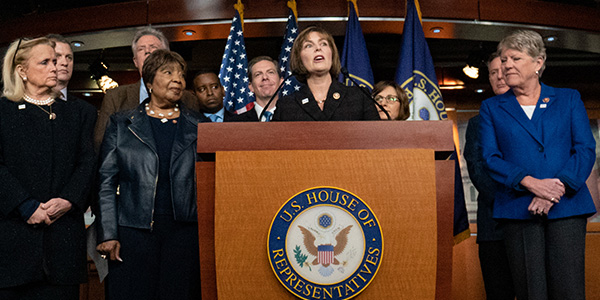House Democrats on Tuesday offered a 547-page Climate Crisis Action Plan, setting a goal of making the U.S. net zero carbon dioxide emissions economy-wide by 2050.
Issued as a majority report of the House Select Committee on the Climate Crisis, the plan says its proposals would reduce net U.S. greenhouse gas (GHG) emissions by at least 37% below 2010 levels in 2030 and 88% below 2010 levels in 2050 and provide almost $8 trillion in climate and health benefits through 2050.
Built around 12 “pillars,” including investments in infrastructure, agriculture, technology and workforce development, the plan identifies “hundreds” of recommendations for legislation. While the proposals are unlikely to advance in the current Congress, they will be central to Democrats campaigning leading into the November elections.
The committee was created in January 2019. Although its plan includes just a single explicit mention of the Green New Deal proposed by Rep. Alexandria Ocasio-Cortez (D-N.Y.) and Sen. Bernie Sanders (I-Vt.), it appears to borrow from it, calling for labor protections and posing climate actions as an economic development driver.
“Environmental justice and our vulnerable communities are at the center of the solutions we propose,” Committee Chair Kathy Castor (D-Fla.) said in a statement. “The health of our families and the air we breathe are at the heart of our plan. We chart the course to good-paying jobs in solar and wind energy, in manufacturing American-made electric vehicles and in strengthening communities, so they are more resilient to flooding, extreme heat, intense hurricanes and wildfires.”
The plan calls on Congress to enact carbon pricing but warns it “is not a silver bullet and should complement a suite of policies to achieve deep pollution reductions and strengthen community resilience to climate impacts.” It said carbon pricing should be accompanied by policies to reduce pollution from facilities located in environmental justice communities and protect domestic industries from unfair competition from foreign competitors with lower environmental standards.
The Democrats said their proposals have been endorsed by more than 90 organizations, including the Natural Resources Defense Council, Environmental Defense Fund, National Wildlife Federation and The Sierra Club.
Republicans on the committee issued a statement chiding Speaker Nancy Pelosi (D-Calif.), saying that rather than seeking a bipartisan approach, she reversed “more than 200 years of House precedent” with rule changes to limit debate.
“Working together provides the best chance of maintaining U.S. global competitiveness and emissions-reducing leadership at home and abroad — without increasing costs on working families,” the Republicans said. “Policies rooted in innovation lower the cost of energy, drive economic growth and cut emissions. Our own experience with the energy renaissance in the oil and gas sector is proof. Economic growth and energy security do not have to be sacrificed in order to improve the environment. In fact, increased production of American shale natural gas helped produce the greatest emissions reduction in history. Our increased production also checks the ambitions of countries, like Russia, that wish to use energy as a weapon.”
Lisa Jacobson, president of the Business Council for Sustainable Energy (BCSE), said the Republicans’ comments on the report “show many areas of alignment for the parties.”
“While the recommendations in this report begin their path through the legislative process, BCSE urges Congress to pass the American Energy Innovation Act, which has amassed strong bipartisan support under the leadership of Senate Energy and Natural Resources Committee Chairman Lisa Murkowski (R-Alaska) and Ranking Member Joe Manchin (D-W.Va.), as a foundational first step,” Jacobson said.
Among the plan’s proposals are the following:
- Create a Clean Energy Standard to achieve net-zero emissions in the electricity sector by 2040 and an Energy Efficiency Resource Standard to address rising electricity demand from electrification. The plan would extend and expand clean energy tax incentives and grant programs.
- Order FERC to develop a long-range transmission infrastructure strategy to site interstate transmission lines in high-priority corridors. “Congress also should direct FERC to remove roadblocks in power markets that slow the growth of electricity generation from clean sources,” it said.
- Expedite deployment of zero-emission technologies where they are already available while setting GHG emission standards for cars, heavy-duty trucks and aviation. It would seek 100% sales of zero-emission cars by 2035 and heavy-duty trucks by 2040.
- Incentivize states and cities to adopt updated model building codes, including net-zero-emission building codes, with a goal of making all new residential and commercial buildings net-zero emissions by 2030.
- Develop new standards for water infrastructure resilience that account for more frequent and damaging floods, droughts and erosion.
- Cut methane emissions from the oil and gas sector by 65% to 70% by 2025 and 90% by 2030, compared to 2012 levels, and eliminate the routine flaring of methane. Update the Federal Power Act to ensure FERC “considers climate science and public input” in siting new natural gas infrastructure. Eliminate oil and gas industry exemptions in the Clean Air Act, Clean Water Act and Resource Recovery and Conservation Act.
- Increase funding for federal clean energy research, development and demonstration and reorganize the Department of Energy around a climate mission.
- Establish performance standards to reduce emissions from industrial facilities, combined with border adjustment mechanisms to address foreign goods made with higher-polluting processes.
- “Dramatically increase” federal investment in carbon removal research and development and improve financial incentives for direct air capture technology.
- Repeal tax breaks for large oil and gas companies and restructure the tax code to support reaching net-zero emissions by 2050. Limit new leasing for fossil fuel extraction on public lands onshore and offshore.
- Create a Climate Adaptation Program to ensure homes, businesses and critical infrastructure can withstand the impacts of climate change. Require any post-disaster rebuilding to meet “climate-informed” standards against flood, wind and wildfire threats.
- Help farmers and ranchers adopt soil health practices to improve their resilience to extreme rainfall and drought.
- Protect and restore ocean and wetland ecosystems, forests and grasslands to sequester carbon and improve resilience to wildfires and coastal flooding.




